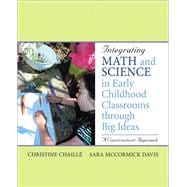Integrating Math and Science in Early Childhood Classrooms Through Big Ideas offers teachers a way to think about the future classroom and to meet the needs of children who come to into it with diverse experience, knowledge, and abilities. “Change how we think about math and science for young children,” the authors say in their Preface. “Instead of separating the disciplines, planning lessons and topics and projects aimed at math OR science content, let’s look at the world the way the child does. Children think in terms of big ideas.”
In this unique book, the authors focus on big ideas—like patterns, transformation, movement, balance, and relationships—as a way to think about content, and they integrate science and mathematics through these big ideas, rather than linking them topically. The book looks at why it is important to think about thinking, introduces assessment early to help the teacher plan for assessment before teaching even begins, and sets up an environment that will support the construction of the big ideas that integrate math and science. Real-life scenarios provide invaluable insights into the teacher’s thinking and planning, and each chapter includes two modules to be used for in-depth exploration of different aspects of the big ideas. It’s a unique exploration of thinking and learning.










